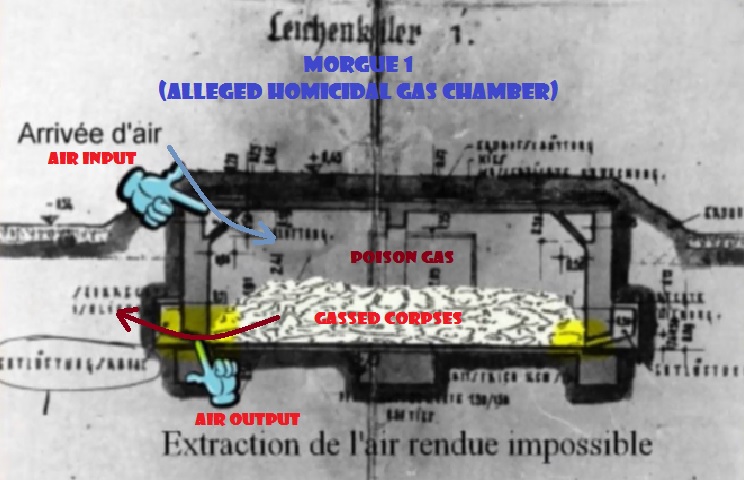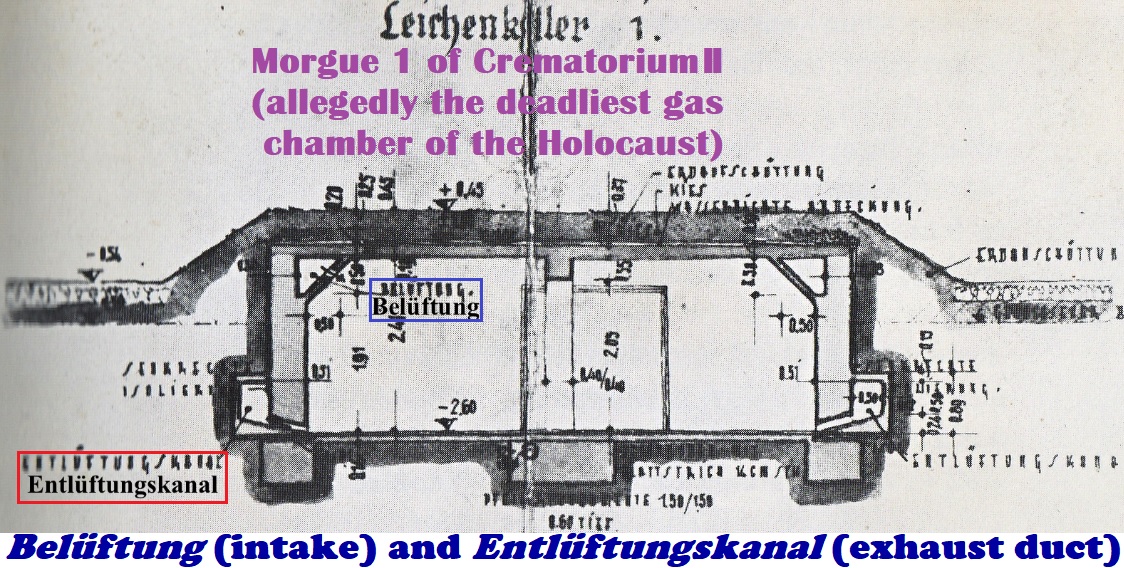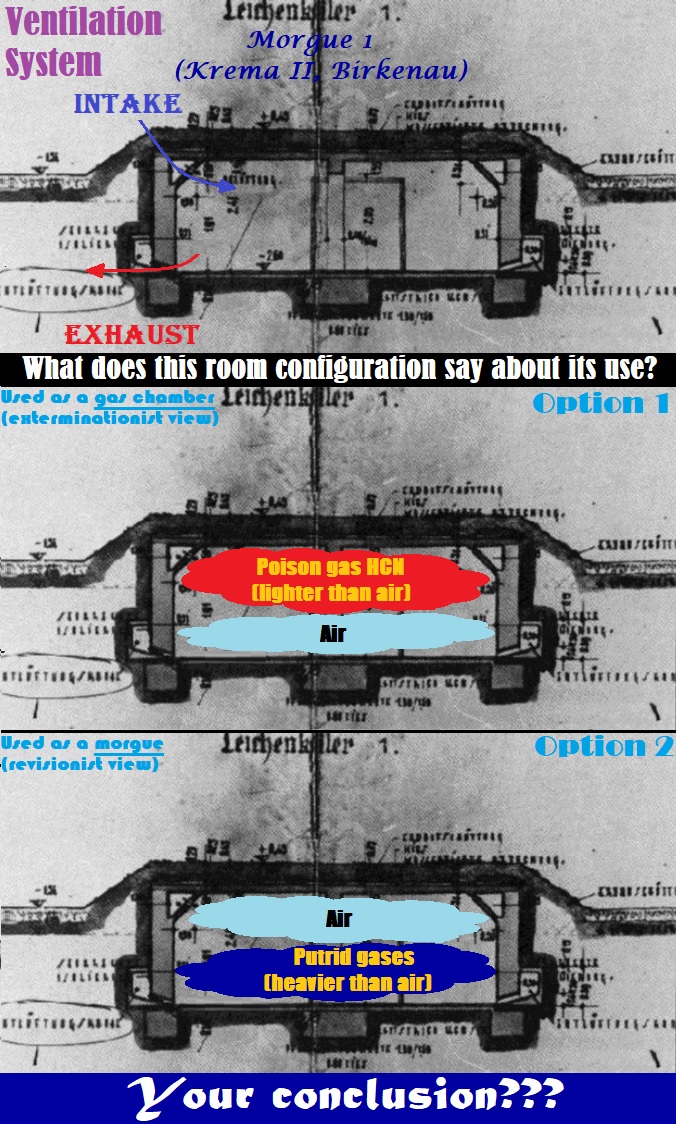- The main alleged homicidal gas chambers of Auschwitz (Kremas II and III) were equipped with ventilation systems. This is often claimed to be evidence that they were homicidal gas chambers
- Actually, the blueprints of the rooms claim that they are morgues, and the ventilation system capacities strongly suggest this use.
- Documents recovered from the camp show that the so-called "Homicidal gas chambers" had a lower ventilation capacity (measured by air exchanges per hour) than the alleged "undressing rooms". Other rooms had an even greater capacity besides the delousing chambers which had by far the greatest
- The ventilation shafts at the bottom of the room, rather than at the top, would have made ventilation impossible with all of the gassed corpses present. Such ventilation designs are useful for a morgue, not a homicidal gas chamber (see my first post for more info)
- Various other structural flaws made the ventilation systems inefficient in general (discussed more in-depth in my most recent post above)
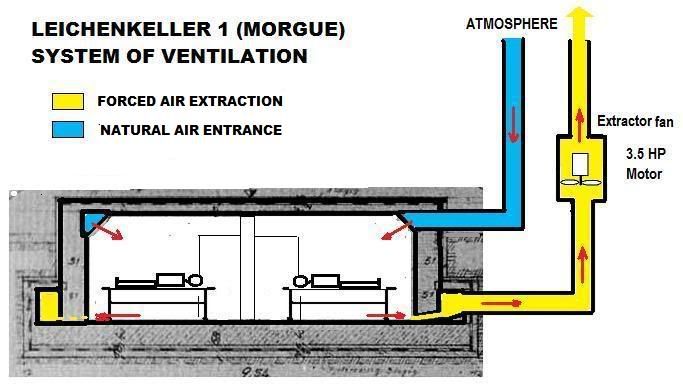
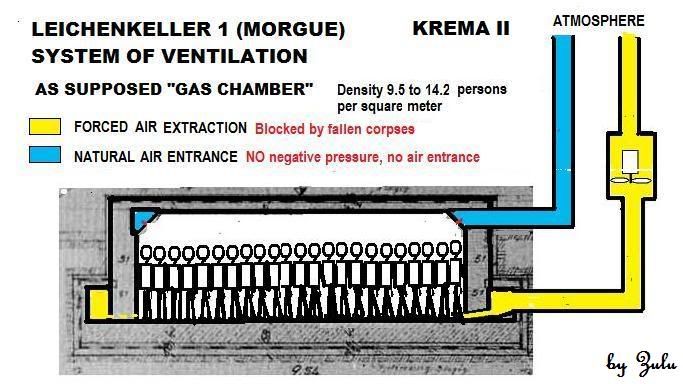
From Germar Rudolf:
5.4.1.2.4. Ventilation Systems
Fact: All rooms in Crematoria II and III were equipped with efficient ventilation installations.[137]
Incorrect conclusion: Morgues #1 of Crematoria II and III were converted into homicidal “gas chambers” equipped with installations for the intended purpose of extracting poison gases.[138]
Correct conclusion: It is in fact inconceivable that a large morgue without windows and with only one door filled with innumerable bodies of the victims of epidemic disease would not be equipped with a ventilation system. The capacity of the ventilation system, however, proves that these installations were designed for typical morgues.[139] The capacity of the blowers can be gleaned from invoices sent to the Central Construction Office by the Topf corporation after installation of the systems.[140] According to this, both Morgues #1, i.e., the alleged “gas chambers” (in the invoice designated as the “B-room”), were each equipped with a 4,800 m3/hr intake and exhaust blower,[141] while for the “L-room” (the so-called “undressing room”) only one exhaust blower was installed with a flow rate of 10,000 m3/hr.[142]
When considering the volume of the two morgues (Morgue #1: 504 m3; Morgue #2: 900 m3), this results in (4,800÷504 =) approximately 9.5 air exchanges per hour for the alleged, planned “gas chambers,” and in (10,000÷ 900 =) approximately 11 air exchanges per hour for the undressing rooms. How come the SS assumed that the “gas chambers” would need less ventilation than the undressing rooms, or even less than the dissecting rooms, laying-out rooms and wash rooms, which had an even greater capacity of approximately 131/3 air exchanges per hour?
Wilhelm Heepke’s classic work on the construction of crematoria states that a morgue requires a minimum of 5 air exchanges per hour and 10 during intensive use (1905, p. 104). Thus it is clear that the ventilation installations provided for the morgues were designed, in terms of orders of magnitude, for morgues in intensive use or for morgues containing the bodies of epidemic-disease victims.
For comparison: professionally designed Zyklon-B-disinfestation chambers with circulating-air systems were equipped with 72 air exchanges per hour (Peters/Wüstinger 1940, p. 195). Furthermore, it should be mentioned that the original plans for a new crematorium in the Main Camp from 1941 – a time when even Pressac admits that the SS had no criminal intentions – provided for 17(!) air exchanges per hour for the dissecting room(!) and the morgues (Pressac 1993, p. 18). This exchange rate is considerably higher than what was later installed for all rooms of the redesigned Crematoria II and III, including the alleged “gas chambers.” Thus, on the way from beneficial planning to allegedly sinister redesign, the air-exchange rates – including that for the claimed homicidal gas chamber – had been drastically reduced (probably in order to reduce costs). This is thus the final refutation of any argument on the alleged criminal characteristics of the ventilation installations in these crematoria.
...
[137] The ventilation ducts of Morgue #1 are visible in the plans published by Pressac 1989, pp. 224, 289; chapter on the ventilation installations of Crematoria II and III: pp. 355ff.; engine power of the ventilation installations for all rooms in Crematoria II and III: p. 374 and 377; size of the ventilation outlets: p. 234; photo of an outlet cover in the ventilation outlets: p. 233.
[138] For Pressac see previous footnote; similar van Pelt 1999, p. 208; Gray 2000, §7.62.
[139] See in this regard Mattogno 2016h, pp. 173-176.
[140] Invoice no. 729 dated May 27, 1943. APMO, D-Z/Bau, nr. inw. 1967, pp. 246f.; ibid., 231f.: invoice no. 171 dated 22. February 1943 for Crematorium II.
[141] The engines’ power, originally set for 2 HP in a November 1941 estimate when the building’s exact specifications had not yet been fully defined, was increased in March 1942 to 3.5 HP – at a time when no criminal intentions can be imputed. The innocuous nature of this power increase is confirmed by the fact that the engine powers were increased proportionally for all the other rooms as well. Since the fan types and thus the flow rates remained unchanged, this change was caused by a more-accurate estimate of the system’s internal friction. This means that the initially calculated back-pressure of 40 mm water column was too low. Incremental calculations for estimating the ventilation-shaft resistances in Crematoria II & III according to engineering handbooks, as performed by Dipl.-Ing. Winfried Zwerenz and me in 1990, have shown that the back pressure to be expected would probably have been higher (in the region of 50-60 mm water column), due, particularly, to the primitive lids with many small holes covering the fresh-air-intake openings. See also Mattogno 2016i.
[142] J.-C. Pressac gives the output of these blowers at 8,000 m3/hr, but without proving it (together with Robert van Pelt in: Gutman/Berenbaum 1994, pp. 210, 232). He probably erroneously and impermissibly increased the fan’s flow rate proportionally to the increased engine power. See the previous note.
The Chemistry of Auschwitz—The Technology and Toxicology of Zyklon B and the Gas Chambers – A Crime-Scene Investigationhttps://holocausthandbooks.com/dl/02-tcoa.pdfGermar continues in another section in the same work: 7.3.2.2. Speed of Ventilation of the “Gas Chambers”
Excerpted:
As shown above, when fresh air and stale air mix together, the concentration of the latter falls to only approximately 37% of the initial value after one complete air exchange, and to approximately 14% after a second exchange.
Data are only available on the ventilation installations in Crematoria II and III, so that at this point we have to ignore all other “gas chambers” in this regard. In Paragraph 5.4.1.2.4, the ventilation capacity of Morgues #1 of Crematoria II and III was shown to have been 4,800 m3 per hour. With a volume of free air in Morgue #1 of 440 m3, the volume of the room would be exchanged once in approximately 5-6 minutes.
For Morgues #1 of Crematoria II and III under consideration at this point, however, a further problem arises. In particular, the ventilation intake was installed only approximately 2 m away from the ventilation outlet in the same(!) wall. The distance to the ventilation outlet on the opposite wall, however, is 7.3 m, i.e., 3.5 times as far. The result, in these cellars, is a “ventilation short circuit,” especially if we assume that the victims of the alleged mass extermination were all piled up together, especially in the middle of the room, which would further lengthen the fresh-air pathway from one side of the cellar to the other. The air blown into the ventilation intake openings would therefore, for the most part, be immediately sucked out through the ventilation outlet openings located nearby.[346] Therefore, it must be expected that the actual ventilation time would be considerably increased in comparison to a perfect mixing of fresh air and stale air as a result of this poor design.
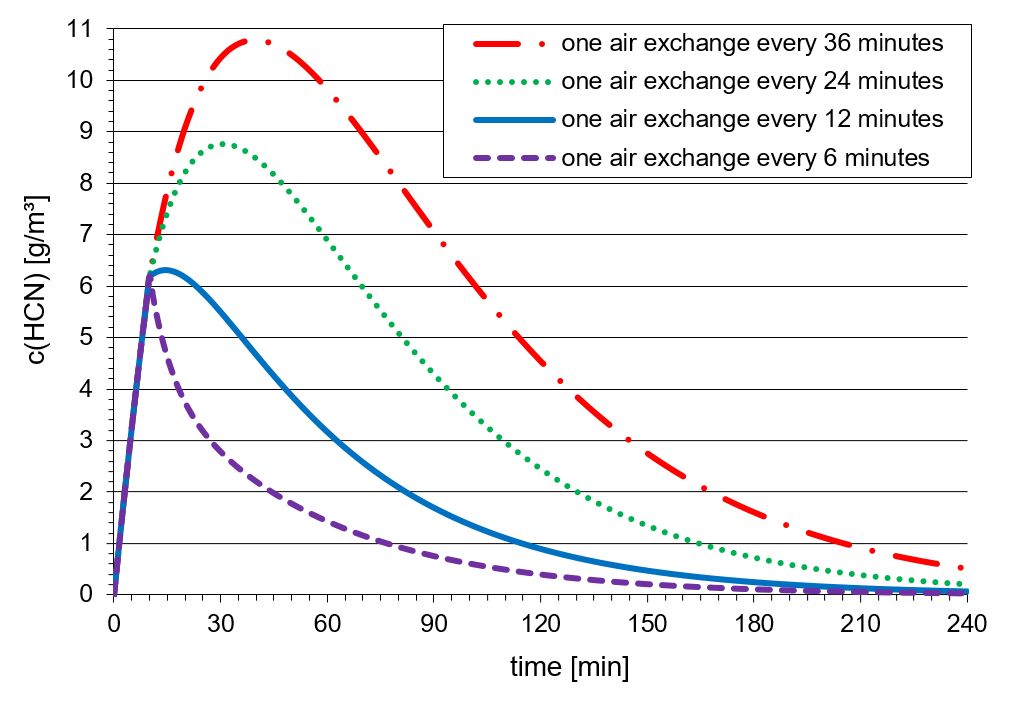
Chart 20: Simulation of the concentration of hydrogen cyanide with time in a hypothetical homicidal gas chamber of the type of Morgue #1 of Crematorium II in Auschwitz-Birkenau; see text.
In addition, if we assume that no wire-mesh introduction columns existed, as has to be assumed on the one hand based on all extant material evidence, and on the other hand because the claimed execution times could not have been achieved with it, the following problem would also arise: the Zyklon-B granules, which in the meantime would certainly have become moist, would lie trapped underneath the bodies in at least some places.


